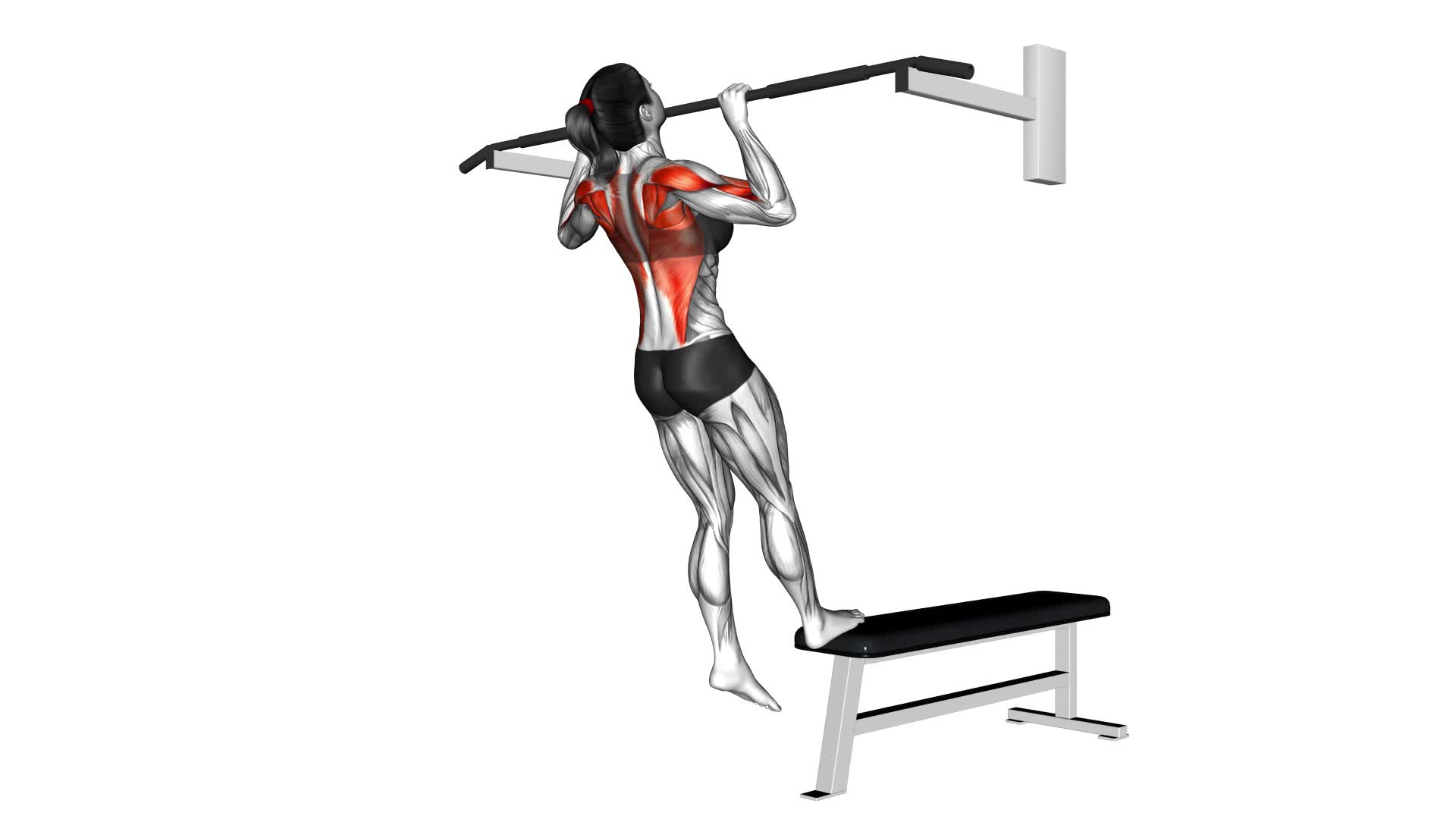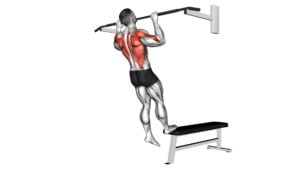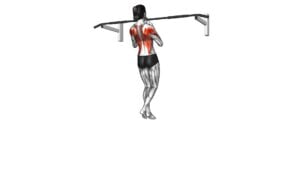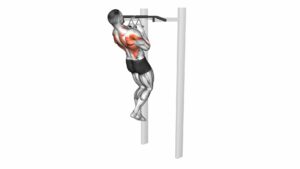Bench Pull-ups (female) – Video Exercise Guide & Tips

Are you looking to strengthen your upper body and build a strong back?
Watch This Exercise Video
Then bench pull-ups are the exercise for you!
In this video exercise guide, we'll show you the proper form and technique to master this challenging move.
With variations to suit your fitness level and expert tips for progression, you'll be able to incorporate bench pull-ups into your workout routine and see amazing results.
Get ready to feel strong and empowered with this effective exercise!
Key Takeaways
- Bench pull-ups are beneficial for women as they can lead to significant strength gains and improve upper body strength.
- Bench pull-ups can aid in weight loss by increasing calorie burn and engage multiple muscle groups including the back, arms, and shoulders.
- Proper form and technique for bench pull-ups include maintaining a straight body, engaging the core, and focusing on using the back muscles to pull up without using momentum.
- Beginners can start with alternative exercises like inverted rows using suspension trainers or resistance bands to gradually build strength before attempting bench pull-ups.
Benefits of Bench Pull-ups for Women
You can experience significant strength gains by incorporating bench pull-ups into your workout routine. Bench pull-ups are a great exercise for women to improve their upper body strength and achieve their fitness goals.
One of the key benefits of bench pull-ups is their effectiveness in helping with weight loss. This exercise engages multiple muscle groups, such as the back, arms, and shoulders, which leads to an increase in calorie burn and overall fat loss. By incorporating bench pull-ups into your routine, you won't only build muscle and strength but also support your weight loss journey.
When comparing bench pull-ups to regular pull-ups, it's important to note that they target slightly different areas of the upper body. Regular pull-ups primarily activate the muscles in the back and arms, while bench pull-ups also engage the chest and shoulders. This makes bench pull-ups a great exercise for women who want to strengthen their entire upper body. Additionally, bench pull-ups can be a more accessible exercise for beginners or those who may not have the necessary upper body strength to perform regular pull-ups.
Proper Form and Technique for Bench Pull-ups
To perform bench pull-ups with proper form and technique, start by positioning yourself on the bench and gripping the bar with an overhand grip. Make sure your hands are slightly wider than shoulder-width apart.
Keep your body straight and engage your core. Lower yourself down by bending your elbows and pulling your shoulder blades together. Aim to lower your chest towards the bar without touching it. Pause for a moment at the bottom before slowly returning to the starting position.
To improve upper body strength, it's important to maintain proper form throughout the exercise. Avoid using momentum or swinging your body to complete the movement. Instead, focus on using your back muscles to pull yourself up.
If bench pull-ups are too challenging, there are alternatives that can still help you strengthen your upper body. You can try inverted rows using a suspension trainer or resistance bands. These exercises target similar muscles and can gradually build your strength until you're ready for bench pull-ups.
Remember to always consult with a fitness professional before attempting any new exercises.
Variations to Challenge Yourself With Bench Pull-Ups
To further enhance your strength and performance with bench pull-ups, incorporating variations can provide an added challenge and diversity to your workout routine.
These advanced modifications can help you push your limits and continue progressing in your fitness journey.
One variation you can try is the weighted bench pull-up. This involves adding extra resistance to your pull-ups by attaching a weight plate or wearing a weighted vest. This will increase the intensity of the exercise and further engage your muscles.
Another option is the single-arm bench pull-up. Instead of using both arms, you'll perform the exercise using only one arm at a time. This variation requires greater stability and core strength, making it more challenging.
If you're looking for equipment options to add variety to your bench pull-ups, you can try using resistance bands. These bands provide different levels of resistance and can help you target specific muscle groups.
Additionally, using gymnastic rings can also be a great option, as they require more stability and control.
Incorporating these advanced modifications and equipment options will challenge your muscles in new ways, helping you reach new levels of strength and performance.
Common Mistakes to Avoid During Bench Pull-ups
Avoiding common mistakes is crucial for optimal performance and results when performing bench pull-ups. To ensure that you're executing the exercise correctly, here are some common mistakes to avoid and tips for proper technique:
- Improper grip: Make sure you have a firm grip on the bar, with your palms facing away from you and your hands shoulder-width apart. Avoid gripping the bar too tightly or with your fingers wrapped around it.
- Lack of control: Maintain control throughout the entire movement. Avoid swinging your body or using momentum to complete the pull-up. Instead, focus on engaging your back muscles and pulling yourself up using your upper body strength.
- Incomplete range of motion: Aim to lower yourself until your elbows are fully extended and then pull yourself up until your chin is above the bar. Avoid cutting the movement short or not fully extending your arms at the bottom.
By avoiding these common mistakes and focusing on proper technique, you'll ensure that you're getting the most out of your bench pull-up workouts.
Now, let's move on to the next section to learn some tips for progression and increasing the difficulty of this exercise.
Tips for Progression and Increasing Difficulty
To progress and increase the difficulty of your bench pull-ups, focus on challenging yourself with variations and adding resistance to the exercise. Incorporating progression tips and increasing difficulty strategies will help you continue to improve and reach new levels of strength and fitness.
One effective way to progress is by incorporating different variations of bench pull-ups into your routine. For example, you can try wide grip pull-ups, where your hands are placed wider than shoulder-width apart, or close grip pull-ups, where your hands are placed close together. These variations target different muscles and add variety to your workout.
Another strategy is to add resistance to the exercise. This can be done by using a weighted vest or attaching resistance bands to the bar. The added resistance challenges your muscles even more, helping you build strength and increase the difficulty of the exercise.
Remember to gradually increase the intensity and difficulty of your bench pull-ups over time. Start with easier variations and lighter resistance, and gradually progress to more challenging variations and heavier weights. This progressive overload will ensure continuous improvement and prevent plateaus in your training.
By following these progression tips and increasing difficulty strategies, you can continue to challenge yourself and make progress in your bench pull-ups.
Now, let's move on to incorporating bench pull-ups into your workout routine.
Incorporating Bench Pull-Ups Into Your Workout Routine
Now, let's talk about how you can incorporate bench pull-ups into your workout routine.
Bench pull-ups are a great exercise that can help you build upper body strength and improve your pulling power. Here are some tips to help you incorporate bench pull-ups into your routine:
- Modifications for beginners:
- If you're new to pull-ups or find them too challenging, you can start by using an assisted pull-up machine. This machine allows you to adjust the weight to make the exercise easier and gradually decrease the assistance as you get stronger.
- Another modification is to use resistance bands. Loop a band around the bench and place your feet in the band to provide some assistance during the movement.
- Bench pull-ups vs. traditional pull-ups:
- Bench pull-ups are a variation of traditional pull-ups, where you perform the exercise with your feet on the ground and your body at an incline. This position can be more comfortable for beginners or individuals with limited upper body strength.
- Traditional pull-ups, on the other hand, are performed hanging from a bar with your body in a vertical position. They require more strength and stability as you're lifting your entire bodyweight.
- Adding bench pull-ups to your routine:
- Start by incorporating bench pull-ups once or twice a week, depending on your fitness level and recovery ability.
- Begin with 2-3 sets of 8-12 repetitions and gradually increase the intensity by adding more sets or increasing the weight.
- As you progress, you can also incorporate other variations of pull-ups, such as wide grip or chin-ups, to target different muscle groups.
Incorporating bench pull-ups into your workout routine can be a great way to challenge yourself and improve your upper body strength. Remember to start with modifications if needed and gradually increase the difficulty as you get stronger.
Frequently Asked Questions
How Many Calories Do You Burn During a Bench Pull-Up Workout?
During a bench pull-up workout, you can burn a significant amount of calories. This exercise targets multiple muscle groups, including your back, arms, and core, which leads to increased calorie expenditure. The more intense your workout is, the more calories you'll burn.
In addition to burning calories, bench pull-ups also help improve upper body strength, posture, and grip strength. So, if you're looking to burn calories and strengthen your upper body, bench pull-ups are a great exercise to incorporate into your routine.
Can Bench Pull-Ups Help Improve Posture?
Bench pull-ups can indeed help improve your posture by strengthening your back muscles. By performing this exercise correctly, you engage the muscles in your back, including the latissimus dorsi and rhomboids, which play a crucial role in maintaining good posture.
To perform bench pull-ups correctly, start by lying face down on a bench with your chest hanging off the edge. Grab the bar with an overhand grip, pull yourself up towards the bar, and then lower yourself back down in a controlled manner.
Are There Any Modifications for Women With Lower Back Pain?
If you're a woman with lower back pain, there are modifications you can make to the bench pull-up exercise.
For pregnant women, it's important to avoid any exercises that put too much pressure on the abdomen. Instead, try modified pull-up variations using a TRX band or resistance bands.
If you have shoulder injuries, focus on strengthening the muscles around the shoulder joint before attempting bench pull-ups.
Always listen to your body and consult with a professional if needed.
Can Bench Pull-Ups Be Done With a Resistance Band?
Bench pull-ups can definitely be done with a resistance band! Using a resistance band as a modification for bench pull-ups can be beneficial in many ways.
It helps to gradually build strength and improve your form. The resistance band provides assistance, making the exercise more accessible for those who are still working on their upper body strength.
This modification allows you to engage the same muscles as regular pull-ups, but with less strain on your body.
Are Bench Pull-Ups Suitable for Beginners?
Bench pull-ups are a great exercise for beginners looking to build upper body strength. There are modifications, progressions, and variations that can be done to suit your fitness level.
Conclusion
In conclusion, bench pull-ups are a great exercise for women to strengthen their upper body and improve their overall fitness.
By following proper form and technique, and gradually increasing the difficulty level, you can challenge yourself and see progress over time.
Remember to avoid common mistakes and incorporate bench pull-ups into your workout routine for maximum benefits.
Keep pushing yourself and enjoy the results of your hard work.

Author
Years ago, the spark of my life’s passion ignited in my mind the moment I stepped into the local gym for the first time. The inaugural bead of perspiration, the initial endeavor, the very first surge of endorphins, and a sense of pride that washed over me post-workout marked the beginning of my deep-seated interest in strength sports, fitness, and sports nutrition. This very curiosity blossomed rapidly into a profound fascination, propelling me to earn a Master’s degree in Physical Education from the Academy of Physical Education in Krakow, followed by a Sports Manager diploma from the Jagiellonian University. My journey of growth led me to gain more specialized qualifications, such as being a certified personal trainer with a focus on sports dietetics, a lifeguard, and an instructor for wellness and corrective gymnastics. Theoretical knowledge paired seamlessly with practical experience, reinforcing my belief that the transformation of individuals under my guidance was also a reflection of my personal growth. This belief holds true even today. Each day, I strive to push the boundaries and explore new realms. These realms gently elevate me to greater heights. The unique combination of passion for my field and the continuous quest for growth fuels my drive to break new ground.







